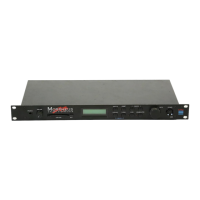Morpheus Operation Manual86
PRESET PROGRAMMING
A Notch Filter is just the opposite of a bandpass filter and is used to
eliminate a narrow band of frequencies.
Another control found on traditional filters is called Q or resonance. A
lowpass filter with a high Q would emphasize the frequencies around
the cutoff frequency. The chart below shows how different amounts of
Q affect the low pass filter response. In terms of sound, frequencies
around the cutoff will tend to “ring” with high Q settings. If the filter
is slowly swept back and forth, with a high Q, various overtones will
be “picked out” of the sound and amplified as the resonant peak
sweeps over them. Bells and gongs are real world examples of sounds
which have a high Q.
Another parameter on a filter is the number of poles it contains.
Traditional synthesizer filters were usually either 2-pole or 4-pole
filters. The number of poles in a filter describes the steepness of its
slope. The more poles, the steeper the filter's slope and the stronger
the filtering action. The tone controls on your home stereo are prob-
ably one-pole or two-pole filters. Parametric equalizers are usually
either two-pole or three-pole filters. In terms of vintage synthesizers,
Moog and ARP synthesizer filters used 4-pole filters, Oberheim synthe-
sizers were famous for their 2-pole filter sound.
Frequency
Amplitude
4-pole
Lowpass
2-pole
Lowpass
Frequency
Amplitude
Low Q Med Q High Q

